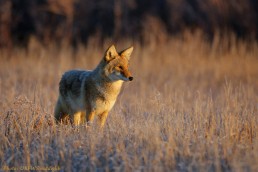Ohio Coyote Specimens Needed for Research Project
SHARE THIS POST
John Hageman asks that Ohio hunters be aware of an ongoing coyote research project by the Ohio State University and the Ohio Division of Wildlife.
There is a new multi-year Ohio State University/Ohio Division of Wildlife statewide coyote study underway to investigate coyote-livestock conflicts and do an in-depth diet analysis for the common predator species.
Under the supervision of OSU Professor Dr. Stan Gehrt, who has done mounds of work on Chicago’s coyotes, some ecology and management questions being investigated include:
• To what extent does the general coyote population consume domestic livestock?
• What are demographic, spatial, and temporal patterns of coyote livestock consumption?
• Do they correlate with livestock production practices?
What other prey items make up significant parts of their diets, such as white-tailed deer? Does it change based upon age, sex, season, or habitat types in Ohio?
As hunting seasons continue to open through the fall and winter, the coyote research team is asking for help getting the word out about their need for coyote specimens and samples of their prey. Fur harvesters are encouraged to contact the coyote team via e-mail (OHcoyote@osu.edu) or phone (614/300- 0754) to arrange times to pick up carcasses.
Are you enjoying this post?
You can be among the first to get the latest info on where to go, what to use and how to use it!
They are also able to use roadkill coyotes. If one is seen, people may contact the researchers to let them know the location so it can be retrieved. In Ohio, it is not legal to retrieve roadkills without a special permit. The carcasses can be examined to determine age distribution, sex ratios, and birth rates (from mature female carcasses.)
In the absence of carcasses, whiskers from coyotes and whisker, hair and feather samples from their prey items will help them determine which animals coyotes are eating and obtain chemical fingerprints that can be used to pinpoint their geographical/environmental origin. To find out how to contribute coyote specimens and view/print a data sheet, go to: https://ohiocoyote.org/node/23. Associated sample collection data are absolutely necessary for the samples to be of any use, whether you are contributing a whole carcass or just whiskers.
To collect whiskers, pull or cut at least 2 to 3 (more is better) of the longest ones with scissors, while trying to get as much of the entire whisker length as possible. If providing whiskers from multiple specimens, place whiskers and a data sheet from each animal in separate zipper bags or envelopes taped shut to ensure that the contents of the bags/envelopes cannot become mixed within the larger package being mailed. If you notify the coyote team via e-mail (OHcoyote@osu.edu), they can send you a postage-paid envelope for your convenience.
Contributing coyote prey items
Prey animals listed on the project website page include cottontail rabbits, opossums, skunks, squirrels, raccoons, other small mammals, turkeys, and other upland game birds. As with the coyote samples, their data sheet, or the same information as above on a plain sheet of paper, needs to accompany submitted prey whisker, hair, and feather samples. To read the procedures of collecting specimens of prey sample material and to view/print the prey data sheet, see https://ohiocoyote.org/node/23.
For detailed information about the project, see: https://ohiocoyote.org.
Read about more interesting conservation efforts in the Midwest in issues of MidWest Outdoors. Subscribe on our website.
MWO
SHARE THIS POST
You may also like...
Nothing found.
Did you enjoy this post?
You can be among the first to get the latest info on where to go, what to use and how to use it!
John Hageman
John Hageman was manager of Stone Laboratory, Ohio Sea Grant's Biology Station at Put-in-Bay, for 25 years and formerly a licensed Lake Erie ice-fishing guide. He is active with the Outdoor Writers of Ohio and several sportsmen's conservation organizations. He may be contacted at hageman.2@osu.edu.
